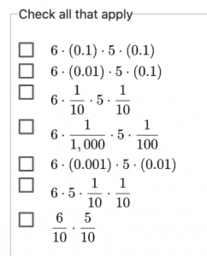IM 6.5.5 Lesson: Decimal Points in Products
In which equation is the value of [math]x[/math] the largest?
How many times the size of 0.81 is 810?
Work with a partner. One person solves the problems labeled “Partner A” and the other person solves those labeled “Partner B.” Then compare your results.
Find each product or quotient. Be prepared to explain your reasoning. [br][table][tr][td]Partner A[/td][td]Partner B[/td][/tr][tr][td]a. [math]250\cdot\frac{1}{10}[/math][br]b. [math]250\cdot\frac{1}{100}[/math][br]c. [math]48\div10[/math][br]d. [math]48\div100[/math][/td][td]a. [math]250\div10[/math][br]b. [math]250\div100[/math][br]c. [math]48\cdot\frac{1}{10}[/math][br]d. [math]48\cdot\frac{1}{100}[/math][/td][/tr][/table]
Use your work in the previous problems to find [math]720\cdot\left(0.1\right)[/math] and [math]720\cdot\left(0.01\right)[/math]. Explain your reasoning.[br][br]Pause here for a class discussion.
Find each product. Show your reasoning.
[math]36\cdot\left(0.1\right)[/math]
[math]\left(24.5\right)\cdot\left(0.1\right)[/math]
[math]\left(1.8\right)\cdot\left(0.1\right)[/math]
[math]54\cdot\left(0.01\right)[/math]
Ancient Romans used the letter I for 1, V for 5, X for 10, L for 50, C for 100, D for 500, and M for 1,000. Write a problem involving merchants at an agora, an open-air market, that uses multiplication of numbers [br]written with Roman numerals.
[math]\left(9.2\right)\cdot\left(0.01\right)[/math]
Jada says: “If you multiply a number by 0.001, the decimal point of the number moves three places to the left.” Do you agree with her? Explain your reasoning.[br]
Select [b]all[/b] expressions that are equivalent to [math]\left(0.6\right)\cdot\left(0.5\right)[/math].
Explain your reasoning.
Find the value of [math]\left(0.6\right)\cdot\left(0.5\right)[/math]. Show your reasoning.
Find the value of the product by writing and reasoning with an equivalent expression with fractions.
[math]\left(0.3\right)\cdot\left(0.02\right)[/math]
[math]\left(0.7\right)\cdot\left(0.05\right)[/math]
IM 6.5.5 Practice: Decimal Points in Products
Find each product:
[math]\frac{1}{100}\cdot\text{122.1}[/math][br]
[math]\frac{1}{100}\cdot\text{11.8}[/math][br]
[math]\frac{1}{100}\cdot\text{1350.1}[/math][br]
[math]\frac{1}{100}\cdot1.704[/math][br]
What happens to the decimal point of the original number when you multiply it by [math]\frac{1}{100}[/math]? Why do you think that is? Explain your reasoning.[br]
Which expression has the same value as [math]\left(0.06\right)\cdot\left(0.154\right)[/math]? Select [b]all[/b] that apply.
Calculate the value of each expression by writing the decimal factors as fractions, then writing their product as a decimal.
[math]\left(0.01\right)\cdot\left(0.02\right)[/math]
[math]\left(0.3\right)\cdot\left(0.2\right)[/math]
[math]\left(1.2\right)\cdot5[/math]
[math]\left(0.9\right)\cdot\left(1.1\right)[/math]
[math]\left(1.5\right)\cdot2[/math]
Write three numerical expressions that are equivalent to [math]\left(0.0004\right)\cdot\left(0.005\right)[/math].
Calculate each sum.
[math]33.1+1.95[/math]
[math]1.075+27.105[/math]
[math]0.9+9.28[/math]
Calculate each difference.
[math]13.2-1.78[/math]
[math]23.11-0.376[/math]
[math]0.9-0.245[/math]
